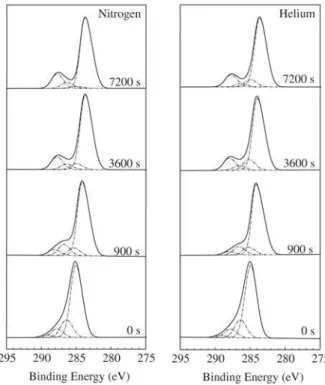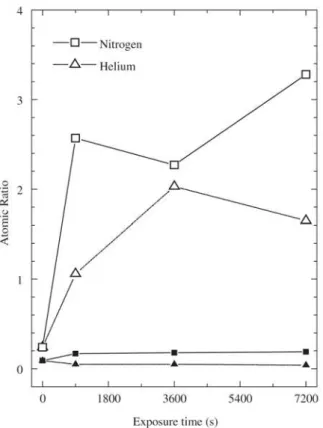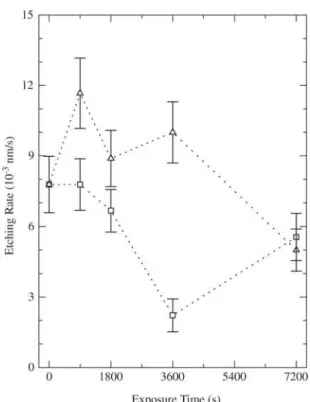*e-mail: elidiane@sorocaba.unesp.br
Article presented at the XV CBECIMAT, Natal - RN, November/2002
Modification of Plasma Polymer Films by Ion Implantation
Deborah Cristina Ribeiro dos Santosa, Rita de Cássia Cipriano Rangela, Rogério Pinto Motaa, Nilson Cristino da Cruzb, Wido Herwig Schreinerc, Elidiane Cipriano Rangelb*
a
Laboratório de Plasmas, Departamento de Física e Química, UNESP, 12516-410 Guaratinguetá - SP
b
Grupo de Plasmas Tecnológicos, UNESP, 18087-180 Sorocaba - SP
c
Laboratório de Superfícies e Interfaces, Departamento de Física, UFPR, 81531-990 Curitiba - PR
Received: January 29, 2003; Revised: April 26, 2004
In this work, thin polymer films were prepared from acetylene and argon radiofrequency (13.56 MHz, 80 W) glow discharges. Post-deposition treatment was performed by plasma immer-sion ion implantation in nitrogen or helium glow discharges (13.56 MHz, 70 W). In these cases, samples were biased with 25 kV negative pulses. Exposure time to the bombardment plasma, t, ranged from 900 to 7200 s. Chemical composition of the film surfaces was investigated by X-ray Photoelectron Spectroscopy and the resistance to oxidation by the etching process, in reactive oxy-gen plasmas. Oxyoxy-gen and nitrooxy-gen were detected in all the samples. While the concentration of the former continuously changed with t, that of N kept practically constant in small proportions. The film is predominantly formed by sp2 states, but the proportion of sp3 hybridization slightly increased with t. The etching rate dropped under certain conditions of nitrogen bombardment whereas helium implantation has not significantly improved it. These results are ascribed to the crosslinking degree of the polymeric chains, ruled by the total amount of energy delivered to the film.
Keywords: plasma polymer, plasma immersion ion implantation, XPS, etching rate
1. Introduction
Polymer films with a great variety of physical and chemi-cal properties can be deposited by plasma polymerization. Through the adjustment of the deposition conditions (plasma composition, pressure, excitation frequency, power, etc), materials with high degree of uniformity, homogeneity and stability can be obtained. They are generally applied as coat-ings for metals, conventional polymers, ceramics, woods, to change chemical, electrical, optical and biological prop-erties1,2.
Another way to modify the characteristics of plasma polymer films is through post deposition treatments. Amongst several techniques, ion beam implantation repre-sents a very effective way of tailoring the properties of
poly-mers to match the requirements of practical applications3-5.
However, such technique is complex and expensive.
Plasma immersion ion implantation, PIII, is a low cost
technique, which enables ion implantation of pieces with complex shapes while keeping the efficiency of conventional
beam implantation6. In the PIII, samples immersed in
reac-tive or noble gas plasmas are biased with high voltage nega-tive pulses. Posinega-tive ions from the plasma are attracted and implanted in the target. The mechanisms of ion energy dis-sipation induce structural and chemical modifications. Es-sentially, the degree of such modifications depends on the total energy delivered to the sample.
In this work, plasma polymerized acetylene films, PPA,
were treated by PIII. An investigation was carried out on
the effect of the exposure time t, and ion mass on the
chemi-cal composition and etching rate of the polymers.
2. Materials and Methods
Films were prepared from acetylene and argon
radiofrequency, RF, plasmas (13.56 MHz, 80 W) in a
cylin-drical stainless steel reactor fitted with two parallel plate
electrodes. The upper electrode is connected to an RF power
Total gas pressure was 12.7 Pa (93% Ar) and deposition time was 1200 s. The average thickness of the films was 50 nm.
Samples were then submitted to nitrogen or helium PIII,
using the same equipment described before. In this case, however, the sample holder was biased with high voltage
negative pulses (25 kV, 30 Hz, 1.3 × 10-7 s). The gas
pres-sure and RF power were 1.3 Pa and 70 W, respectively. PIII
base pressure was 0.4 Pa and exposure time varied from 900 to 7200 s.
The chemical composition of the film surfaces was in-vestigated by X-ray Photoelectron Spectroscopy in a VG
ESCA 3000 system. Base pressure was 2 × 10-8 Pa and no
attempt was made to remove surface contaminants. The
spectra were collected using MgKα radiation and the
over-all energy resolution was approximately of 0.8 eV. The C1s peak (284.6 eV) was taken as reference for the energy cali-bration of the other species. The high-resolution peaks were deconvoluted into their components, using a Gaussian pro-file with linear base. Polished silicon was employed as substrate in this case.
To investigate the etching rate, R, samples were exposed
to RF oxygen plasmas (50 W, 1.3 Pa) in the same
experi-mental system used for film deposition and treatment. A glass mask was applied to protect part of the film surface from the chemical attack, generating a step between the covered and etched region. With the aid of a Veeco Dektak
3 profilemeter, the step height, h, was measured and R
evalu-ated through the following expression:
R = h / σ
where s is the exposure time to the etching plasma, equal to 1800 s in this work. For such analysis, samples were prepared onto mi-croscope glass plates.
3. Results and Discussions
XPS analysis revealed the presence of C, O and N in all the samples. Oxygen incorporation can be explained by the presence of free radicals or dangling bonds in the polymeric
structure7. High concentrations of such species are normally
encountered in plasma polymer films as well as in those
treated by plasma techniques1,5. Furthermore, residual
at-mosphere in the reactor during the deposition can account
for N and O incorporation7.
The C 1s spectra of the films bombarded for different times with nitrogen or helium ions are depicted in Fig. 1. For comparison, the spectra of the as-deposited sample is
also shown (t = 0 s).
The highest component of the C 1s envelope is centered
at 284.6 eV and is related to C-C and C-H bonds in the sp2
coordination. The peaks at 286.1, 287.5 and 288.9 eV are
respectively attributed to C–O (sp2), C=O (sp3) and O–C=O
(sp3) groups. As can be observed there is variation in the
shape of the C 1s peak as t increases. The intensity of the
lines related to O-containing groups grows continuously
resulting in a shoulder (t = 900 s) and finally in a well
de-fined secondary peak (t = 3600 s).
From N 1s and O 1s high-resolution spectra, O/C and N/C atomic ratios were evaluated. The results are presented in Fig. 2. As a general trend, O/C increases after implanta-tion, but the growth rate depends on the exposure time and ion species. At this point, it is interesting to take into con-sideration some phenomena taking place in polymers dur-ing the bombardment.
The deposition of energy in polymers promotes, amongst other processes, bond breakage with emission of atomic and
molecular species3. It was verified that H groups are
prefer-entially lost since they constitute side groups or chain
ter-mination in polymers6. Once H is a weakly bonded species,
just its progressive emission enhances the medium strength of the structure. Moreover, it induces dangling bonds, which are unstable species and tend to be vanished through chain unsaturation and crosslinking.
Consumption of radicals through these processes de-pends on a number of factors, including their concentra-tion, separation and chain mobility. The more radicals are generated, the higher is the probability of recombination and then of crosslinking and unsaturation. Structure strength
is strongly affected by these processes.
Thus, the concentration of residual radicals left in the film treated, called here residual radicals, is a balance be-tween their production and consumption. As mentioned before, they are responsible for atmospheric O
incorpora-tion into the structure1. It has been proved in earlier studies
(by Spin Paramagnetic Resonance) that the intensity of the ion bombardment rules the proportion of residual radicals
and then of oxygen in plasma polymer films8.Therefore,
variations in O/C can be taken as an indicator of the con-centration of residual radicals in the film.
Analyzing the behavior of O/C in the sample exposed
to nitrogen PIII, it can be stated that the concentration of
residual radicals is practically the same in the 900 and 3600 s bombarded samples. Thus, the extra amount of radi-cals produced in the film treated for 3600 s is certainly being consumed by chain crosslinking and unsaturation.
The final increase in O/C suggests that, for the longest bombardment time, the connectivity of the backbones is no longer improved. As the bombardment proceeds, polymeric
chains crosslink, turning the structure rigid9. Polymer
mo-bility is essential to the crosslinking process and then, if further bombardment is performed, new radicals are
gener-ated but recombination is hindered by the immobile struc-ture. In this case dangling bonds are generated and are not re-established. Radicals keep active and the solid prone to oxidation as the sample is exposed to the atmosphere.
From the data presented in Fig. 2 it can also be observed that the rate of modification is slower in samples bombarded with helium ions. In this case, the final increase in O/C (ob-served in the graph of nitrogen treated samples) is not de-tected in the whole range of exposure time investigated. This result can be ascribed to the different mechanisms of he-lium and nitrogen energy dissipation. According to
estima-tions with the TRIM (TRansport of Ions in Matter) code3,
for the same treatment time and energy, the degree of ioni-zation produced by helium is sensibly lower than that in-duced by nitrogen. Therefore, the concentration of free radi-cals and consequently the modifications promoted in the material properties are smaller.
The proportion of nitrogen in the samples is very low, as revealed by the magnitude of N/C (Fig. 2). The small decline in this ratio after helium treatment indicates that N incorporation took place only during the deposition proc-ess (residual nitrogen in the reactor) and it is lost during the bombardment.
In the case of nitrogen implanted films, N/C is higher than in the as-deposited sample. From the invariance of N/C in the implanted films, it can be said that the concen-tration of nitrogen in the surface is independent of the ex-posure time or, equivalently, of the ion dose. The explana-tion for that lies on the fact that, at the energy employed in this work, implanted ions reach deeper regions (120 nm for
N+) lying in the substrate and not in the body of the film
(~ 50 nm thick). Only small concentrations of low energy nitrogen of the plasma are incorporated in shallower layers, accounting for the higher N/C values.
Figure 3 and its insert show the proportion of sp3 and
sp2 coordination in the films as a function of t. These results
were evaluated from XPS data according to the method
pro-posed by Nuzzo10. While the proportion of sp3 bonds
(in-sert) increases, the concentration of sp2 states decreases. This
trend is more pronounced in films bombarded with nitro-gen ions. It is worthwhile mentioning, however, that the
bombarded layer is predominantly formed by sp2 states, with
no pure sp2 or sp3 regions9,11,12.
It has been reported that nitrogen incorporation in the surface of amorphous carbon films enhances the
propor-tion of sp3 hybridization12. In addition to the chemical
ef-fect, the deposition of low energy (~ 100 eV) through ionic
collisions is known to promote sp3 bonds in such
materi-als11. Thus it can be concluded that the treated surface is
composed of a three-dimensionally connected, crosslinked and amorphous structure in which carbon atoms co-exist in
the tetrahedral (sp3) and trigonal (sp2) forms.
Figure 4 shows the etching rate of the films, R, as a
tion of the treatment time with helium or nitrogen ions. R
grows in the sample bombarded with helium for 900 s and it keeps practically unchanged in the 900 s nitrogen
bom-barded film. Further increasing t promotes reduction of R
for both ionic species. This trend is again reversed into growth in the film bombarded with nitrogen for 7200 s.
To interpret these results it should be considered that in polymers, the removal of C-containing groups is strongly
dependent on connectivity of the carbon backbone9. The
increase in R (helium treatment) suggests that the
crosslinking degree is smaller than in the as-deposited film. For lighter ions, ionization power is lower. Small concen-trations of sparsely distributed radicals are generated in a way that, crosslinking is not effective. Instead, connections initially existent are broken and are not restored. In this case, the implantation effect is of degradation.
In the samples bombarded with nitrogen, however, the generation and recombination of pendant bonds are more frequent, improving the connectivity of the carbon network. Hence, the structure strength increases and the etching rate
decreases. The enhancement of R in the sample bombarded
for 7200 s suggests that there is saturation and the
implan-tation effect is again converted into degradation. This fea-ture is attributed to the increase in the strucfea-ture rigidity in-hibiting more crosslinking. The same behavior, however, was not observed in the samples bombarded with helium. As discussed before, the modifications produced by helium ions are less intense due to their lower ionizing power.
Finally, comparing the etching rates of the as-deposited and helium bombarded films, it can be concluded that, un-der the conditions employed in this work, helium bombard-ment was not effective to improve the oxidation resistance
of the films. On the other hand, nitrogen PIII (t = 3600 s)
reduced R to a half of its initial value, corroborating the
idea that the crosslinking degree is higher in such samples. These results are in agreement with the O/C behavior and with the interpretation proposed for the free radical con-centration in the films.
4. Conclusions
In this work, it was verified that surface chemical com-position of PPA is dependent on the exposure time to the
PIII as well as on the mass of the implanted species. There
was variation in the concentration of O in the films with t.
Figure 4. Etching rate of films implanted with nitrogen or helium ions as a function of t.
Figure 3. Proportion of sp2 C bonds in the films as a function of
the treatment time. The insert plot shows the proportion of sp3
This was ascribed to changes in the concentration of re-sidual radicals left in the film after the treatment.
Results revealed that bombarded layer is predominantly
composed by sp2 carbon hybridization and that crosslinking
and unsaturation degree increased under moderate nitrogen bombardment. Saturation occurred only in the highest time nitrogen treated sample. On the other hand, helium treat-ments do not significantly enhanced crosslinking. As a con-sequence, oxidation resistance was not improved but it dem-onstrated almost 100% of improvement as the bombardment was performed with nitrogen for medium exposure times.
In a general way, the modifications induced by nitrogen were more pronounced than that induced by helium. These results were ascribed to the different mechanisms of he-lium and nitrogen energy dissipation into the sample.
Acknowledgements
The authors would like to thanks Brazilian agencies FAPESP and CAPES for financial support and Professor Mário Antonio Bica de Moraes, from IFGW of State Uni-versity of Campinas (UNICAMP) for the thickness meas-urements.
References
1. Yasuda, H. Plasma Polymerization, Academic Press,
N.Y., 1985.
2. Borucki, S.V.; Achete, C.A.; Jacob, W. Surface and
Coat-ing Technology, v. 138, p. 256-263, 2001.
3. Lee, E.H.; Rao, G.R.; Mansur, L.K. TRIP, v. 4, n. 7, july
1996.
4. Rangel, E.C.; Cruz, N.C.; Moraes, M.A.B. de; Lepienski,
C.M. Surface and Coating Technology, v. 127, p. 93-98,
2000.
5. Hutchings, R.; Short, K.T.; Tendys, J. Surface and
Coat-ing Technology, v. 83 p. 243-249, 1996.
6. Dong, H.; Bell, T. Surface and Coating Technology,
v. 111, p. 29-40, 1999.
7. Durrant, S.F.; Baranauskas, V.; Peterlevitz, A.; Li, B.B.; Tosin, M.C.; Rangel, E.C.; Wang, J.; Castro, S.G.; Moraes,
M.A.B. de thin Solid Films, v. 355-356 p. 184-188, 1999.
8. Rangel, E.C. in “Implantação Iônica em Filmes Finos
Depositados por PECVD” PhD Thesis, State Univer-sity of Campinas - UNICAMP, ch. 4.1, Campinas, SP, 1999.
9. Lee, E.H. in: M.K. Ghosh, L.K. Mittal (Eds), Polyimides:
Fundamentals and Applications, p. 471, New York
1996.
10. Jackson, S.T.; Nuzzo, R.G. Applied Surface Science
v. 90, p. 195-203, 1995.
11. He, X.M.; Bardeau, J.F.; Walter, K.C.; Nastasi, M. J.
Vac. Sci. Technol., v. 17, n. 5, p. 2525-2530, 1999.
12. Lu, W.; Komvopoulos, K. Journal of Applied Physics


